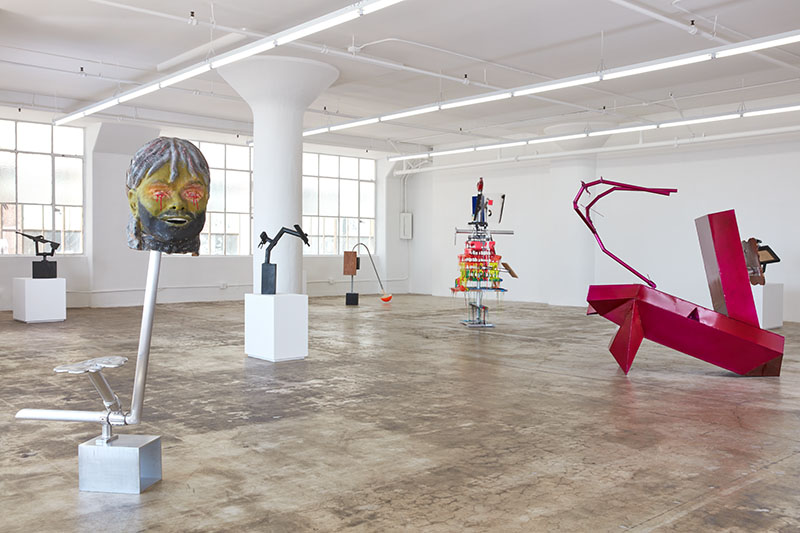When does an exhibition title effectively amount to a viewer advisory? I’m not sure Harry Dodge would consider the title of his current show at JOAN gallery, “Works of Love,” an instance of this. It’s not in any sense a caution, and the titles of the individual works freely contradict or complicate this intention. But both the titles and more importantly the works themselves reflect a posture that veers between deflection or distraction and abject immersion.
The placement of Accidental Megastructure (2018) closest to the entrance might serve as a groundwork for the terms and conditions of Dodge’s “love” for exchange or expression here. “Megastructure” would be the human form itself—here represented as a grotesque over-the-head carnival mask (originally an Incredible Hulk mask). There’s no indication Dodge has seriously altered it, although the “blood” seeping from the eyes looks like an addition and the hair seems expressionistically enhanced. Below this mask at the base, is what might be a kind of reversible mask—the sort of face seen in a silvery cloud, one that might be read upside down or from either side, its mouth really a kind of beak defined by proboscis and jaw, of a piece with the sorts of blob-like heads that seem to routinely crop up in Dodge’s drawings and installations.

Harry Dodge, Black Transparency (The Cloud Polis draws revenue from the cognitive capital of its Users) (2017), courtesy of the artist, photo by Paul Salveson.
From the human form and its most evanescent sublimation, Dodge moves towards a domain clearly inspired by AI and robotics. Megastructure (or monstrosity) gives way to instrumentality—being in the world as catalyst or cataclysm. Most of the sculptures have similar armatures constructed of aluminum tubes and panels of wood or Plexiglas joined by aluminum speed-rail joints; but whether human and “mega,” exigent or futuristic, feral or simply “strange,” Dodge’s mega-machines are dark handmaidens with several of the sculptures cast in bronze. In Feral Sympathy (Works of Love #4) (2017), a jumper cable is clamped to Dodge’s pump-jack half-mask (with another clamp at its “tail”). Invisible Helpers (Works of Love #2) (2017) are not just visible, but emphatic, with their rake-like digits (or teeth) and framed viewfinder “eye.” In the worldview Dodge gives us here, it may be that the viewers themselves are the future “invisible.”
We understand from Dodge’s written statement that his notion of “being-with” (as a “practice of love”) does not exclude the non-human. The “Works” however raise two questions: does it also (following the terms of the theoretical writing of Édouard Glissant that informs Dodge’s thinking) encompass the complex, organic “non-single” being we know as the human; and can we really call an artificial intelligence that, however autonomous, remains the product of human manufacture, “non-human?”
Dodge doesn’t call all of the works in this exhibition “works of love.” From “Work of Love #5” titled, The Monstrous Interval (2018), also in cast bronze but with a distorting mirror framed opposite a pair of rotor-like attachments—as if to remind us how mutable we are—we move on to a black urethane-soaked sock that looks more like an oil-slicked crustacean than Dodge’s title for it—Pure Shit (2017). But this is a mere trial balloon by comparison with Dodge’s Pure Shit Hotdog Cake (2017), whose armature is elaborated by multiple receding trays, dripping in neon-colored magenta, neon-yellow, green and orange. Black, white, gray and silver dripping top to bottom are effectively the binary through-line. The speed-rail joints brandish their painted Plexiglas panels like shields, while an orthogonal transversal projects a decontextualized photograph of itself on one side, effectively both representation and virtual extension. The hot “sausage” atop this wedding cake is almost beside the point. The elaborate structure effectively wags the dog, reduced here to vehicle/receptacle for what might be called Van Gogh yellow condiments.
In a similarly elaborate work, explicit in its allegorical intent, Black Transparency (The Cloud Polis draws revenue from the cognitive capital of its Users) (2017), extensions threaten to fly off a vertebral stepped base, while yellow polyethylene buckets cascade a sheet of tar-black resin. Again, this seems less about an affective response to “being-with” our AI-endowed technology, than its material consequences.
Dodge’s struggle to evolve “being-with” is not far removed from the more fundamental problem of consciousness that is simply being in the world—the human consciousness of having reduced its biosphere to instrumentality and all but destroyed it. Love is both too inclusive and exclusive to serve as an apology; and it doesn’t need to be. Dodge’s “Works” here point to a larger leap—from the visible to the invisible, and the inevitable existential anxiety of that erasure.


